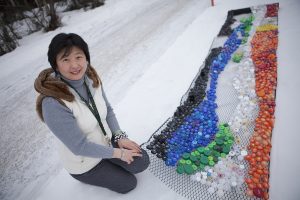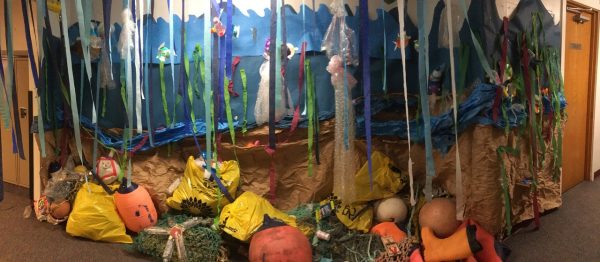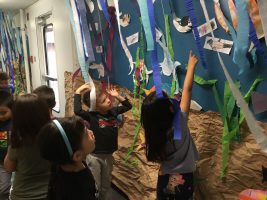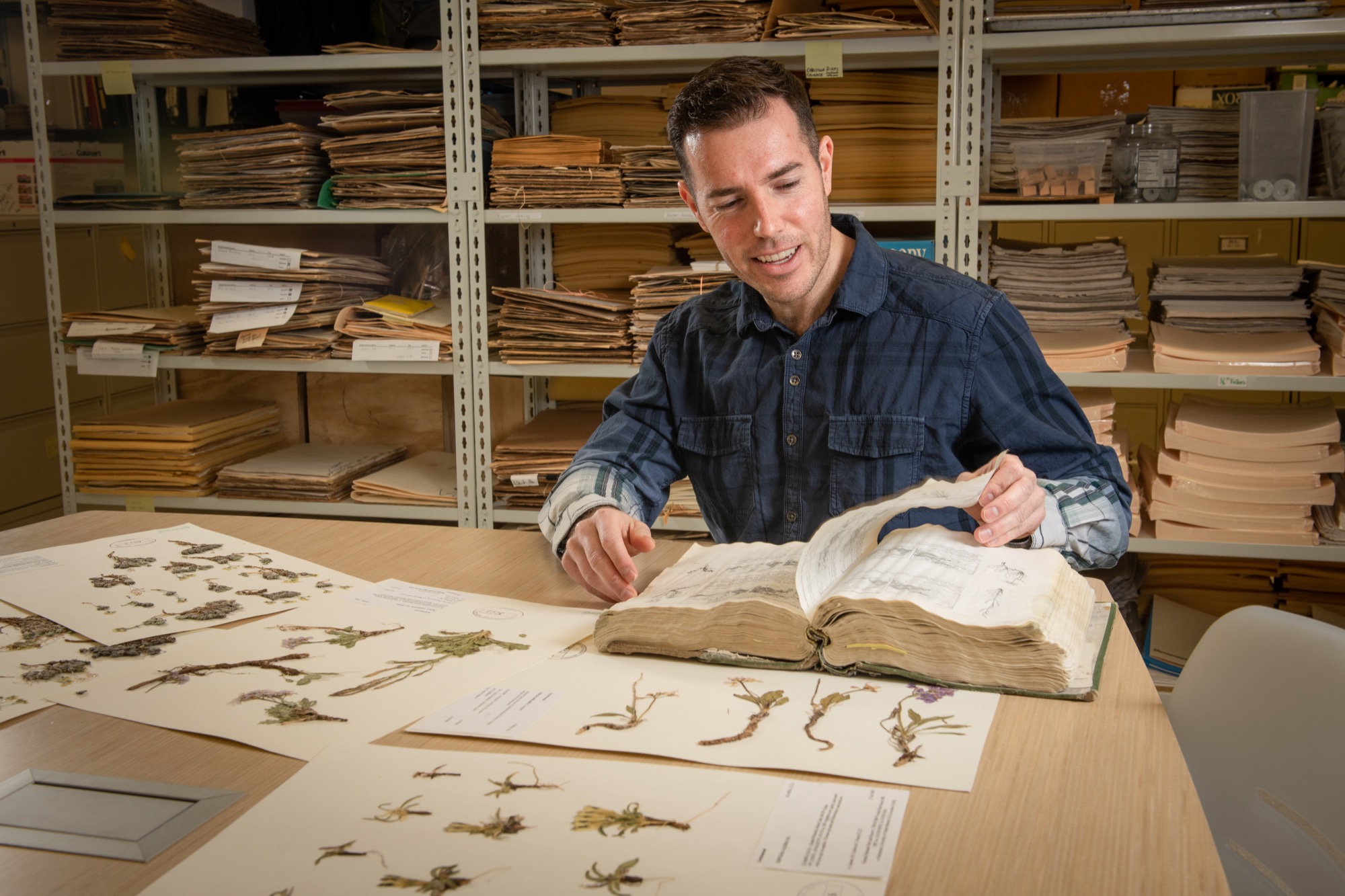Microplastic is the new plastic
by cmmyers |
In the 1950s, plastic was hailed as the new "it" material that would transform every household in America and banish many modern housewives' woes. Fast forward to 2018 and the mass production of the material has created more than 8 billion tons worldwide - 79 percent of which has landed either in a landfill or somewhere in the natural environment. Since 2010, about 8 million metric tons has littered the world's oceans, and with no end of plastic production in sight, scientists and wary citizens across the globe are looking for ways to educate people and mitigate the harmful effects it has on the environment.

Herminia Din, UAA professor of art, art education and art appreciation, poses next to her art installation during Winterfest in 2014. Din has spent more than a decade using art as a way to rethink how we can turn junk into art and reduce plastic waste. (Photo by Phil Hall/ University of Alaska Anchorage)
Herminia Din, professor of art, art education and art appreciation in UAA's Department of Art, has for the past 15 years focused her career and research on using art to educate students from kindergarten to college, on how to reduce their carbon footprint. Din specializes in community-based art education, and since 2008, has been advancing her Junk to Funk project by taking everyday items that may otherwise be discarded to the trash bin, and upcycling them to a functional, yet aesthetically pleasing piece of art. At UAA, Din was also one of the visionaries behind the Winter Design Project - Art, Light, Play, a campus community event celebrating winter in the far north. Throughout her career, Din has had a lot of experience educating not only students at UAA, but youth across the state and this past year, her efforts have shifted to the ocean and the plastic that keeps filling them up.
Plastic island
In September 2018, Din touched down on St. Paul Island, a 43-square mile volcanic island in the Bering Sea and the largest of Alaska's Pribilof Islands. Din was invited by Veronica Padula, a doctorate student working in UAA Professor Doug Causey's lab, who was helping coordinate Bering Sea Days, a weeklong collaborative event where scientists from across the state are invited to teach the 100 or so group of K-12 students of St. Paul School.

The hallway of St. Paul School on St. Paul Island was transformed into a floor-to-ceiling underwater art installation during Bering Sea Days. (Photo courtesy of Herminia Din)
Din set up shop in one of the school's hallways to create a floor-to-ceiling art installation that, by the end of the week, had spread out onto the tiled floors. "We transformed the hallway throughout the entire week and talked about the impact that plastic has in our life," Din said, further saying the students really enjoyed the project and were excited to add a little bit more to the art project every day. It was a great opportunity for them to not only flex their creative muscles, but to also start having the conversation about waste pollution.
In her free time, Din headed to the island's beach, walking the shoreline and finding discarded fishing nets, plastic containers and other pieces of wayward trash that had either been picked up by the wind or washed up on the beach from the churn of the ocean. She said Padula had orchestrated a beach cleaning session with some of the older students, who'd filled giant yellow bags and hauled it back to the school for sorting.
"A lot of it was domestic, but there were foreign objects. Kids would pick up a can and say, 'Do I recognize this character?' - they were either Japanese or Chinese," said Din, explaining that Alaska's coastlines are often littered with our own residents' trash, but that in recent years, trash from far off places turns up on our state's rocky coastlines as it is carried by the current of the sea.

Din said each day students at the K-12 school added pieces like sea animals to the art installation. (Photo courtesy of Herminia Din)
"It makes me sad. Since starting this plastic pollution project, I've just been looking around my own neighborhood in Anchorage and seeing how much we litter," Din said. Last spring, she traveled to Nanwalek and Port Graham on the southern tip of the Kenai Peninsula for a similar art education project as her Bering Sea Days trip, and although the coastline was fairly clean, the small communities' inland trash was an issue - something she realized that in remote Alaska, is a real problem. "Most of the trash that I found on the beach or pathways was domestic because they don't have landfills or a waste management system and the amount of plastic these communities use."
This has long been an Alaska issue, how to dispose of waste in an economical and environmentally friendly way - especially for communities off the road system, like St. Paul Island, Nanwalek and Port Graham.
Pop-up book
"On one side is the plastic ocean and on the other side is the clean ocean," said Din, describing her latest project, a pop-up book designed to help communicate and illustrate the consequences of a plastic ocean. "When you read the book every page shows the plastic in our lives and on the other side, if we do all the big 'Rs,' then we'll have a happy ocean."
Din said she geared the book to elementary school students, and hopes to have the book in all Alaska school and public libraries once it is published in March. She plans to use the book as a conversation starter to continue her community art projects and education outreach on reducing plastic waste not only in Southcentral but in rural Alaska, too.
The pop-up book, still in production, was made possible through UAA's INNOVATE grant program, a research grant program that allows faculty across a broad spectrum of fields to perform research to solve local and global issues in new imaginative ways.
She said she believes if she can teach the younger generation better habits than their parents, then maybe we can start turning things around. She said it may seem like one little change here, like swapping out a plastic spoon for a metal one, is insignificant, but the power of the majority is huge in tackling this issue.
In her own life, Din practices what she espouses and always has on hand a reusable cutlery set, a foldable cup for drinking water and a tote that compacts down to about the size of a coin purse. Even Din's accessories reflect her "junk to funk" philosophy from her earrings made of recycled scraps of paper.
Din said that we have come to a turning point as a society and global community on the issue, and there are few places left in the world untouched by plastic. Most worrisome to her is the new microplastic invading the world's oceans and the fish and animals that are consuming the invisible pieces floating through their ecosystems.
Din boils it down to simply asking, do we want a "happy ocean or the plastic ocean?"
Written by Catalina Myers, UAA Office of University Advancement
 "Microplastic is the new plastic" is licensed under a Creative Commons Attribution-NonCommercial 4.0 International License.
"Microplastic is the new plastic" is licensed under a Creative Commons Attribution-NonCommercial 4.0 International License.














